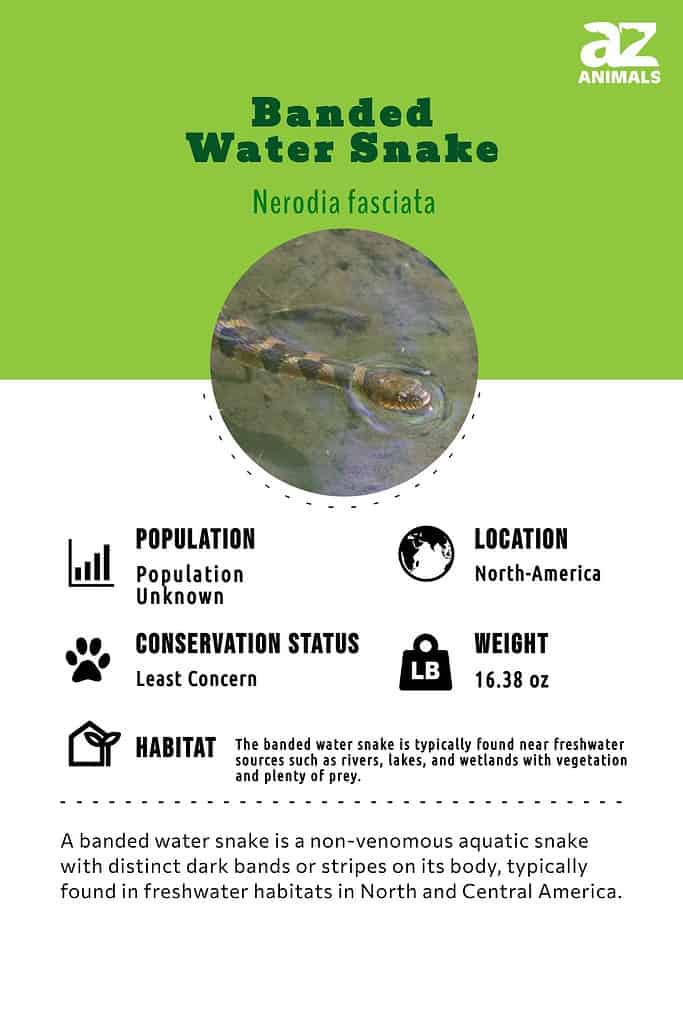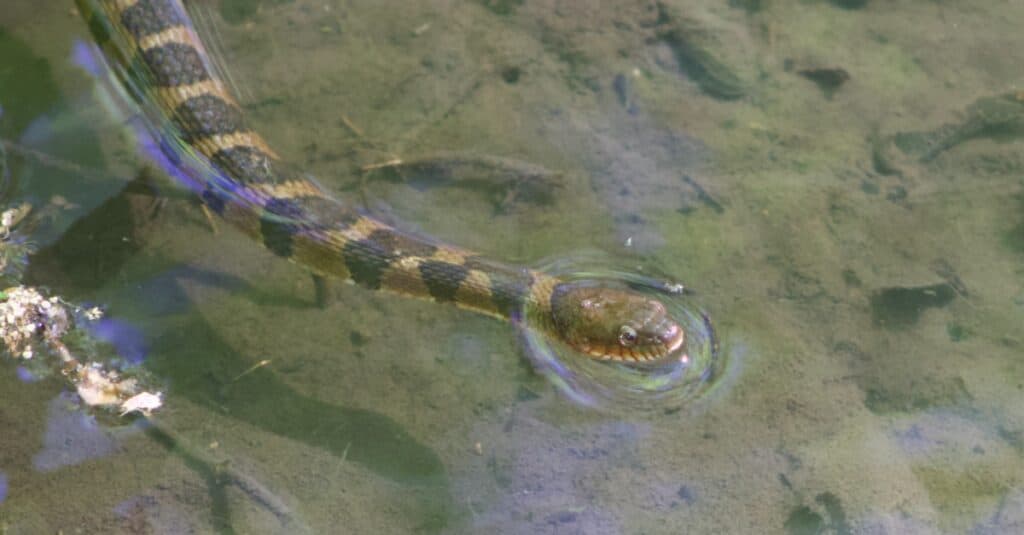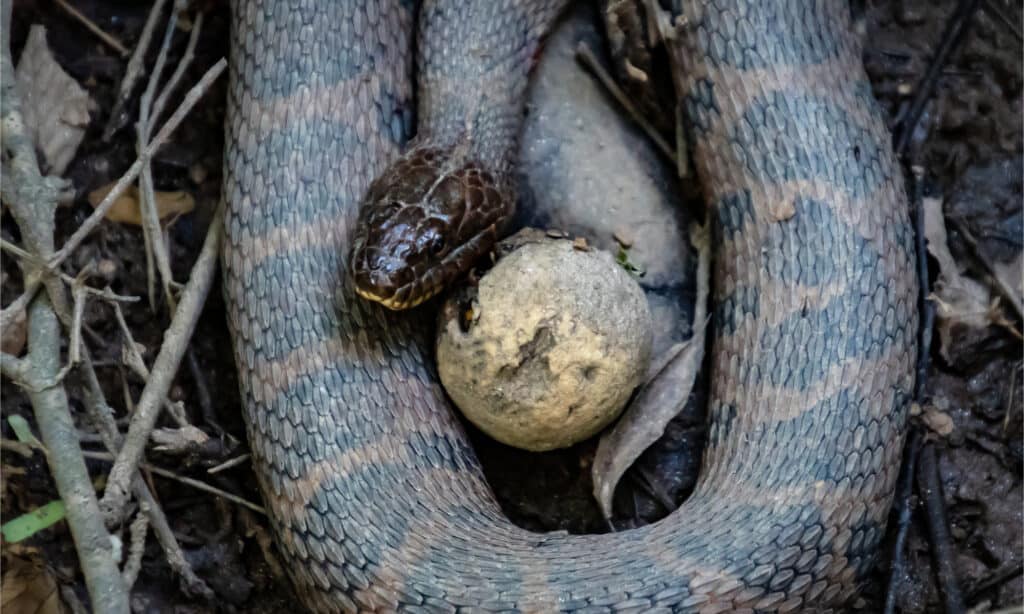Banded Water Snake
Nerodia fasciata
Some water snakes defend themselves violently.
Advertisement
Banded Water Snake Scientific Classification
- Kingdom
- Animalia
- Phylum
- Chordata
- Class
- Reptilia
- Order
- Squamata
- Family
- Colubridae
- Genus
- Nerodia
- Scientific Name
- Nerodia fasciata
Read our Complete Guide to Classification of Animals.
Banded Water Snake Conservation Status
Banded Water Snake Facts
- Prey
- Frogs, fish and birds
- Group Behavior
- Solitary except during mating season
- Fun Fact
- Some water snakes defend themselves violently.
- Distinctive Feature
- Vertical bars around the lip scales
- Litter Size
- 8–40
View all of the Banded Water Snake images!

“The snake with the sideways bite.”
Banded water snakes are heavy-bodied, non-venomous reptiles of medium size. They’re semi-aquatic and come in variable colors. You can find them from North Carolina to Alabama along the Coastal Plain, among other regions of the United States. The creatures hybridize with northern water snakes where the Coastal Plain meets Piedmont.
These snakes play a big role in the environment by controlling the populations of their main prey, such as certain fish and amphibians.
3 Incredible Banded Water Snake Facts!

©iStock.com/Dalene Capps
- Perceiving a threat, to appear larger, banded water snakes flatten their bodies use anal glands to emit a foul smell, and then bite repeatedly.
- The banded water snake is mistaken for the water moccasin or cottonmouth but isn’t venomous.
- If they take a nice deep breath beforehand, this reptile can stay underwater for two hours or longer.
Where to Find the Banded Water Snake

©iStock.com/passion4nature
Banded water snakes live primarily along the United States Coastal Plain from North Carolina to Southwest Alabama. They are also at home in parts of Florida, Texas, and Arizona.
The nonvenomous snakes keep near streams and ponds as they prefer vegetated ponds and lakes. You’ll also find them in shallow waters like ditches, streams, rivers, swamps, wetlands, and marshes. They appreciate North Carolina’s habitats for its freshwater aquatic habitats.
This snake enjoys lounging on logs and branches hanging over the water. They’ll forage for amphibians and fish in shallow water. Prey on their diet is chiefly frogs, fish, and small birds.
Banded water snakes are protected in the state of Georgia. In other locations, they’re pretty common but have no real protections. As a species, the medium size snakes are currently listed as “Least Concern.”
The categorization means the species doesn’t qualify for Endangered, Vulnerable, Near Threatened, or Critically Endangered on the IUCN Red List. The identification is greatly influenced by the large number of snakes caught in trappings. This indicates a thriving and invasive population in many regions.
Evolution and Origins
With the earliest known fossils dating to between 143 and 167 Ma ago, snakes are assumed to have developed from either burrowing or aquatic lizards, possibly during the Jurassic period.
Non-venomous water snakes are a common sight in North America and, as their name suggests, enjoy hanging out in or near bodies of water.
Nearly all freshwater environments, such as ponds, lakes, streams, rivers, wetlands, swamps, and marshes, are home to banded watersnakes. Habits: Banded watersnakes are active day and night and are frequently spotted close to different watery habitats.
Several innocuous water snakes have died as a result of not being able to distinguish between the two species.
Types of Banded Water Snakes
The banded water snake consists of three subspecies: the southern watersnake (Nerodia fasciata fasciata), the broad-banded water snake (Nerodia fasciata confluens), and the Florida watersnake (Nerodia fasciata pictiventris). Each subspecies is differentiated primarily by geographic distribution.
Due to profoundly poor vision, these reptiles are active after dark, though it’s not unusual to see them prowling during the day in shallow water locations hoping to catch a bite of fish or other small creatures they can diet on.
Scientific Name
The semi-aquatic banded water snake, or Nerodia fasciata, is part of the Colubridae snake family. The Colubridae is the largest snake family with 250 genera. The Colubrid snake is in locations on every continent except Antarctica.
The 9 Different Types of Water Snake
Here are several species that are cousins of the nonvenomous banded water snake.
- Harter’s water snake or Brazos River water snake (Nerodia harteri)
- Northern water snake with four subspecies (Nerodia sipedon)
- Brown water snake (Nerodia taxispilota)
- Florida green water snake (Nerodia floridana)
- Green water snake or Mississippi green water snake (Nerodia cyclopion)
- Diamondback water snake (Nerodia rhombifer)
- Plain-bellied water snake with four subspecies (Nerodia erythrogaster)
- Concho water snake (Nerodia paucimaculata)
- Salt marsh water snake or saltmarsh snake with three subspecies (Nerodia clarkii)
Population and Conservation Status
The banded water snake, or southern water snake, is a nonvenomous species of aquatic reptile found in many United States locations. They are made up of many colors including brown, olive, gray, and red with dark bands or splotches on their backs.
In its southern habitats, the snakes are active all year long. In other habitats, they’re inactive during the winter. During the colder months, the snakes take refuge under piles of vegetation found near water or live out the cold in burrows. The snakes are nocturnal by nature and during the most intense heat are active at night.
If cornered, the banded water snake flattens its body and head. This makes them appear larger, mimicking a dangerously venomous snake. If the threat doesn’t go away, the snake goes aggressive. They attack viciously, tearing the skin with their bite. They also release a horrible smell if stepped on or picked up.
According to the IUCN Red List, the banded water snake’s classification is Least Concern. Outside of large birds of prey like the great blue heron, larger snakes, and other semi-aquatics like alligators, the banded water snake faces no major threats of record.
There has been a reduction in, or elimination, of the aquatic vegetation the snakes use as habitats due to drainage or removal of wetlands. We want to note many of these animals are often killed by frightened people mistaking them for the venomous cottonmouth. (The banded water snake shares its habitat with the cottonmouth.) They are also victims of roadkill.
Overall, the populace is healthy and widespread. So, currently, there are no conservation measures to protect the banded water snake.
Appearance and Description

Banded Southern Water snake
©Deborah Ferrin/Shutterstock.com
Banded water snakes are of medium size, roughly between 24–48 inches. Colors vary, ranging from black to ground color to reddish with dark crossbands.
The crossbands are large down the middle of the back and narrower on the snake’s sides.
How to identify a banded water snake:
- Growth size of two to 3½ feet with a max of five
- Identification includes color ranges of yellow-tan to grayish-brown with brown-black crossbands that don’t extend to the belly
- Crossbands are larger in the middle of the back, and narrower on the sides
- Over the lifespan, crossbands obscure as the snake darkens
- Squarish spots align the sides of the belly
- There are dark stripes from the eye to the jaw
Venom: How Dangerous Are They?
Water snakes are among the most common in the country. Several species can be aggressive and, if cornered, violent, but none of the species are venomous.
Often mistaken for other species of harmless water snakes, individuals who have tried to handle them learned too late they’ve made a mistake. Their favorite prey is slimy and hard to hold, so their teeth are extremely sharp; water snakes bite in such a way that they rip through the skin when snatching their heads back. And they attack repeatedly.
But this snake is more likely to run as long as they have somewhere to go. If taken by surprise or cornered, they will defend themselves.
Behavior and Humans
Depending on the region, the snakes are active day or night, though they lean toward being largely diurnal. They move slowly along bodies of water, feeding mostly on aquatic creatures like fish and frogs. With a good gulp of air, they dive beneath water surfaces and stay for almost two hours. They prefer rivers, swamps, marshes, and ponds. It’s their way to avoid predators as they hunt.
The banded water snake is not friendly toward humans, but neither is it dangerous. It can become aggressive when surprised or touched. They’re not bred for captivity and would likely not do well in cages. They are solitary creatures and prefer muddied waters. They are sociable before and after hibernating over the winter.
View all 284 animals that start with BBanded Water Snake FAQs (Frequently Asked Questions)
Are banded water snakes venomous?
No, they are not. These snakes have some nasty bites, but they are not predators or poisonous and do not seriously harm humans.
How do banded waters snakes hunt?
The banded water snake will patiently slink and wait for prey in or around bodies of water. They attack quickly, disabling with an ugly bite, often running off with their catch.
Are banded water snakes aggressive?
Only when perceiving a threat. The facts are if you come upon one unawares or accidentally step on the snake, they react violently. They do not like handling either. These identification traits make them terrible house pets, though the experienced handler does keep them.
Where do banded water snakes live?
You can find them all over the United States around bodies of water along the Coastal Plain from North Carolina to Alabama. That puts them in Georgia, Florida, Mississippi and other states. The nonvenomous banded water snake is endemic to ponds, lakes, marshes, rivers, swamps and more.
What do banded water snakes eat?
As predators, these snakes diet on fish, frogs, and small birds found in their habitat.
What is the lifespan of the banded water snake?
The lifespan of the banded water snake is three years in captivity and eight in the wild.
What is the snake's lifecycle?
Typically, baby-banded water snakes are born between May and August. The birth period can vary based on subspecies. The baby is born with long, bright patterned skin. Like their parents, the baby is aggressive, bites, and releases a stinking musk. The baby reaches maturity between its second and third years.
What are the differences between copperheads and banded water snakes?
The major differences between copperheads and banded water snakes lie in their looks and how they attack prey and intruders.
Thank you for reading! Have some feedback for us? Contact the AZ Animals editorial team.
Sources
- Savannah River Ecology Laboratory: UGA / Accessed January 23, 2022
- Department of Wildlife Ecology & Conservation / Accessed January 23, 2022
- Amphibians and Reptiles of North Carolina / Accessed January 23, 2022
- Animalia / Accessed January 23, 2022
- Snake Removal / Accessed January 23, 2022
- kidadl / Accessed January 23, 2022
- LIVESCIENCE / Accessed January 23, 2022
- Snake Facts / Accessed January 23, 2022
- HongKongSnakeID.com / Accessed January 23, 2022
- Animal Spot / Accessed January 23, 2022
- The National Wildlife Federation / Accessed January 23, 2022
- Wikipedia / Accessed January 23, 2022


















